
The Retrogaming Times
- The Bimonthly Retrogaming Hobbyist
Newsletter -

The Retrogaming Times
- The Bimonthly Retrogaming Hobbyist
Newsletter -
| The Retrogaming Times |
|
|
Our sixth issue is packed with content across the expected variety of hardware and subjects. While many may be familiar with Sylvester Stallone's outings on the Nintendo Entertainment System and Sega Master System, Sly also had a few Commodore 64 adventures. Find out if they were blockbusters or busts in this issue's More C64! I'm sure we all have an unfamiliarity with video game hardware that falls outside of our gaming generation or interest. Occasionally an opportunity to check out that mysterious hardware will present itself, as it did to Jerry Terrifying with the Atari 5200. Video game collectors often have specific items in their collections that mean the most to them, whether they are due to rarity or a personal connection. Todd Friedman is no exception and a special item of his was taken on an unexpected adventure worthy of legend. A new barcade has opened up in the San Francisco Bay Area and Donald Lee is looking for your opinions on if it's hit or miss. Final Fantasy is a franchise with a tremendous legacy and an even larger fanbase. "Mighty" Matt D. talks about his origins with the series, what it offers to gamers in a world of changing tastes, and if the modern incarnations still hold up to the titles of the past. This past holiday season the hottest video game item was Nintendo's NES Classic Edition, a plug-and-play miniature Nintendo Entertainment System with thirty built-in games. Supplies were extremely limited, driving the cost up to ridiculous prices, and causing some gamers to swear off attempting to acquire one until interest died down. Is this modern throwback worth all the hype? Todd Friedman takes a look at the system to find out. Not to be confused with a telephone receiver, The Controller Chronicles showcases the Intellivision controller. And the CoolBoy 198 in 1 Famicom multicart serves up a host of launch titles for both the Famicom and NES, while the 400 in 1 cartridge features a tactical strategy game of significant importance with a dubious reputation online.
As we kick off 2017 I want to remind our
readers if they have comments or questions about anything covered in the
newsletter, or there is something they would like featured in a future
issue of The Retrogaming Times, to let us know via The Retrogaming Times
on Facebook at facebook.com/theretrogamingtimes
or contact me directly at trt@classicplastic.net! There is a lot
planned for the year ahead but the one thing that will never change is
our commitment to publishing retrogaming focused content created by retrogaming
hobbyists.
|
Pintastic Pinball & Game Room Expo, July 6th - 8th 2017, Sturbridge, Massachusetts, USA
Do you love pinball? Are you looking for a little relief from the hot summer sun? Look no further than Pintastic New England, which is the first of its kind, centrally located in Sturbridge, Massachusetts. This expo is 30,000 square feet of fun for the whole family. The kids can have never-ending excitement with a caricature artist, face painting, balloon animals, magic, and relieve all of their pent-up energy with a bouncy house. The adults can bring out their inner child with over 200 pinball machines set on free play, all while enjoying an ice-cold beer.
For more information, visit https://pintasticnewengland.com/
~ ~ ~
KansasFest, July 18th - 23rd 2017, Kansas City, Missouri, USA
KansasFest is the world's only annual convention dedicated to the Apple II computer that revolutionized the personal computing industry. Held every year in Kansas City, Missouri, KansasFest offers Apple II users and retrocomputing enthusiasts the opportunity to engage in beginner and technical sessions, programming contests, exhibition halls, game tournaments, and camaraderie. Any and all Apple II users, fans, and friends are invited to attend this year's event, this year marking the 29th annual convention.
For more information, visit http://www.kansasfest.org/
~ ~ ~
Retropalooza, October 7th - 8th 2017, Arlington, Texas, USA
A celebration of all things retro! Retropalooza was started in 2013 in Arlington, Texas by a couple of guys who enjoy all things retro; from toys to music, to video games... especially video games. As video game collectors, they spent a lot of time and money looking for retro games when they figured it would be easier to bring the games to them. Thus, Retropalooza was born.
The goal of Retropalooza is to bring nerds from all walks of life together for an enjoyable, family friendly time. Good old fashioned fun with like minded people where it will always be affordable, and forever improving.
For more information, visit http://retropalooza.com/
~ ~ ~
If there is a show or event you would like
listed here, free of charge, please contact David directly at trt@classicplastic.net.
Please include a short official blurb about your event along with any relevant
links or contact information and it will be published in the next issue
of The Retrogaming Times. The event listing will remain posted until
the issue following the event date. Big or small, we want to promote
your show in our newsletter. Check out these great events, shows,
and conventions and let them know you read about them in The Retrogaming
Times!
|
Back in the day film tie-ins could not
rely on voice samples and digitized faces. The Commodore 64 played host
to many famous film stars, and no less than three games based on Sylvester
Stallone movies. But which is the best?
FIRST BLOOD
1986 was a tricky year for Ocean. Its licensed properties were a real mixed bag - Highlander (based on the film, with some amazing Martin Galway music) was terrible and Miami Vice failed to impress (despite its Grand Theft Auto style gameplay - and more Galway sounds). Short Circuit at least tried something different. It was Rambo that signaled an improvement.
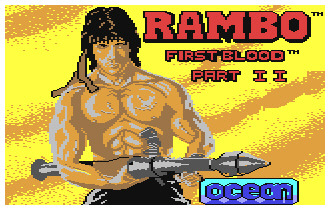
The loading screen of
Rambo
The second Rambo film was bloody, taking the hero back to Vietnam on the orders of his Colonel. The game though did not feature blood. It did feature overlaid sprites, a technique programmer Dave Collier was perfecting at Ocean. This meant placing a high-resolution sprite (creating a black outline) over a multi-colour sprite. The two combined to give a more detailed character. The game's plot followed the movie, broken down into three key sequences.
- Make it to the POW camp and free the captive.
- Get to the helicopter and fly back to liberate more captives.
- Fight the gunship and escape across the border.
Rambo starts out on foot with three weapons - his trusty knife, his bow & arrow and explosive arrows. A machine gun can be quickly picked up, but it makes noise - attracting more enemy patrols. Get to the POW camp and the knife is used to cut free a prisoner staked out on a frame. Fleeing north, Rambo reaches a helicopter and flies it back to the camp. Landing and taking a rocket launcher with him, he must find the cage and free the remaining POWs. Back in the helicopter he must fly north again, evading or destroying the pursuing gunship before landing at a friendly base.
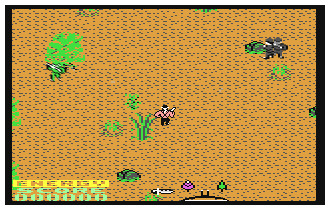
In the jungle Rambo chucks
knives at anyone in sight
It's a tricky game that takes time to learn. What drives the player on is the excellent Martin Galway music, based on elements of the film's soundtrack. Sound FX are strong and the rest of the graphics are reasonably good. There would be better film-based games from Ocean in the future, but it was heading in the right direction.
RATING: Four grenades out of five.
CRIME IS THE DISEASE
That same year, Stallone starred in a very different movie - the crime thriller Cobra, with Stallone as Marion "Cobra" Cobretti who is a very violent cop. Rescuing Brigitte Nielsen from the clutches of a villain should have made a good game. But the end result is appalling.
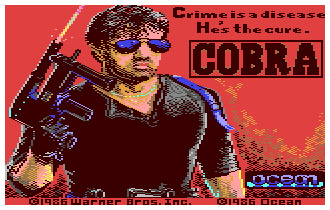
The loading screen for
Cobra
Over three levels, Cobra has to find and rescue his girlfriend. On level one she is waiting at the right-hand end of the level and must be escorted back to safety - but she is kidnapped by the evil gang again. On level two Cobra must reach the factory where she has been taken, walking through woodland. And the final factory level has the nasty boss waiting at the end. Extra weapons can be collected, including the pistol, grenades and laser-sighted machine gun. Picking up burgers restores energy. But what makes the game so bad?
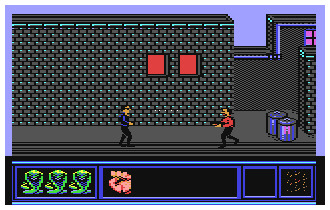
What you can't see is
the terrible animation and strange death routine
The sprites and backgrounds are terrible. Worse is the way defeated enemies die - flashing different colours before fading out. Strange enemies including an exploding pram and a mad axeman. Precision jumping and terrible AI makes escorting the girlfriend a real chore. The later levels are even worse, remarkably short and packed with enemies. The atmospheric tune by Ben Daglish feels completely out of place and is the only redeeming feature.
RATING: Two snakes out of five.
INVADING AFGHANISTAN
Remember when America was backing the rebels fighting against the Russians? John Rambo does, in the third film of the series. With its horse riding and battle against the odds, it's a turkey that should really have been the end for the character. This time John has to rescue Colonel Trautman before teaming up with the Muslims.
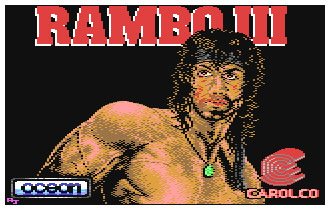
The best depiction of
Stallone, from the loading screen of Rambo III
The game follows the plot of the film, but stretches the first part (rescuing the Colonel) too much. Viewed from overhead there are elements of stealth as Rambo makes his way past guards. The graphics are very dull and the sound FX forgettable. Things improve with the later levels, especially the tank battle. A reasonable 3D effect sees Rambo drive a tank, fighting off gunships, tanks and soldiers. In the end it all feels boring.

Creeping around the Afghan
prison in Rambo III (left), Commandeering a Russian tank to escape Afghanistan
in Rambo III (right)
RATING: Three horses out of five.
So, a very mixed bag for Stallone on the
C64. There was surprisingly no boxing game based on Rocky, and it's a pity
no one licensed the soccer-based World War II movie Escape to Victory.
There have been more Rambo games on other formats, right up to the modern
arcade game with its huge shooting screen. He leaves in his wake many bullet-soaked
corpses...
|
Good day retrogaming readers, and welcome to another edition of Retrogaming Feels. Lately, with the release of the 15th installment on November 29th, I've had Final Fantasy on the brain. I went to the midnight release at my local Gamestop store, and as I waited along with other fans for 12:00 to roll around, it dawned on me that I have been playing these games my entire adult life. There's always been something special about the series. Love it or hate it, it's undeniable that Final Fantasy brought JRPG's into mainstream gaming for many Americans. Times have changed so much during the 26 year history of the series in North America, it's hard not to get nostalgic for its beginnings.
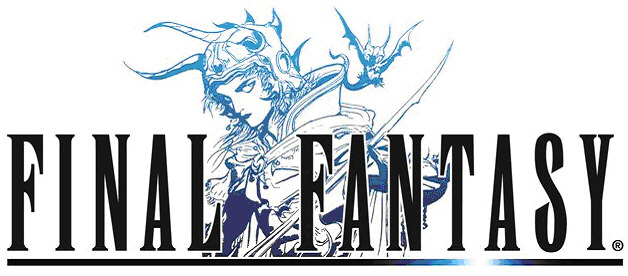
I first discovered the game through its announcement in Nintendo Power magazine. They had a contest in which the winner got to take their friends on a real treasure hunting adventure in the Virgin Islands. A prize of this value indicated a major release worthy of my attention. Not only did the contest seem amazing, the game itself was of a caliber I'd not experienced on the NES. Up to this point the only RPG's I had played on the NES were Dragon Warrior and Ultima: Exodus. Both games were good for different reasons. Dragon Warrior was 3 years old before making its debut in North America, and it showed its age with simple gameplay. What it lacked in depth, it made up for with an appealing graphic style and excellent music. Ultima offered much more complexity with detailed battle scenes, a party of varied characters "rolled up" by the player, and a challenging quest. This came at a cost of being difficult to grasp for the uninitiated, graphics that were a bit muddy, and a forgettable soundtrack. I found Ultima to be the better game, but enjoyed the look and approachable nature of Dragon Warrior.
Final Fantasy offers the best of both worlds. There is a very polished look to it. Gone are the screenfuls of text and stats that are typically present in RPG's from this era. Stats visible to the player are simplified, only the essentials like hit points are shown. The computer is still crunching all the necessary numbers to determine things like whether or not you hit that goblin with your giant axe, and if so how much damage it did. You just don't see it - and I find I like that just fine. Other parts of a complex adventure, like a huge bestiary, expansive world, and large catalog of items give the game weight. The NES cart came packaged with a poster showing dungeon maps, item lists, and even a mini strategy guide to show the new player the ropes of RPG's. I love extras like this, and miss them dearly from newer releases.
What sets Final Fantasy apart from other RPG's is its flexibility. It is as complex as you want it to be. It can be a straight run through the main story arc, or hundreds of hours of sidequests to track down every treasure and piece of equipment there is. The optimal equipment and stat tweaking are there, hidden just beneath the surface if you want to look, but aren't needed to enjoy the adventure. The feeling of progressing, of growing and evolving your characters, is always there, and has always been the most important thing to me.
That is the heart of the feels for Final Fantasy, and for all RPG's for that matter. Video games always offer some form of escapism, and in Final Fantasy this feeling is powerful enough to cause the player to disregard all manner of responsibilities. Regardless of what's going on in your real life, it's hard not to get a little charge out of gaining another experience level. In the course of the adventure, you'll find something that was lost, bring rain to the desert, and ease the suffering of strangers. You're stronger without setting foot in a gym. Richer without putting in any extra hours at work. People with problems are looking to the light warriors to solve them - and you get it done.
Like a good book, you can't do it all in one sitting. You have to put it down, tend to pesky real life matters, and come back to it later. It takes many visits, over weeks and maybe even months, to finish the story. That sounds like a bit of a drag, but really it's one of the keys to why Final Fantasy is so addictive. Knowing that you have something to come back to, something with familiar characters but unknown challenges ahead is a big draw. While virtually all modern games match this description, 1990 NES gamers hadn't necessarily been exposed to the idea that one continuous game could last that much time. It marked the introduction of the fantasy epic for many young gamers, and it did so with style.
26 years of the franchise hasn't been without its ups and downs. A post of "Which FF is your favorite?" never fails to start serious discussions, weighing the pros and cons of each entry in the series. Someone loves the same entry ten others claim to hate, and no one is wrong. The only constant in the series is change. Well, that, and Cid. Cid is always around in one form or another.
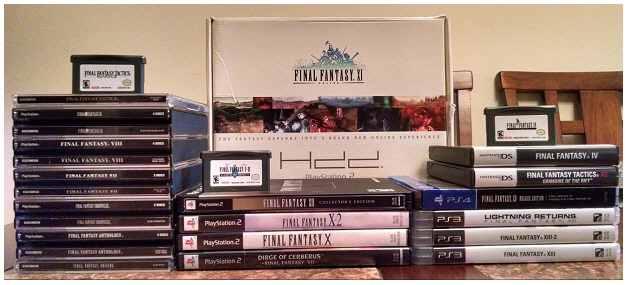
My personal collection
- I sold my NES and SNES carts long ago, because who would want to hold
on to silly things like that? *sniff*
The game has its origins in traditional Tolkein-esque fantasy, with the obligatory dragons, elves, and imps to slay. Your party braves the forests and the mountain pass to get to the cave that holds the forgotten relic, and it feels like an RPG "should." It's easy to forget this looking at the other entries in the series, which feature environments ranging from outer space (FF8) to Route 66 (FF15). Even the very first game ended up in a space station at one point - perhaps a hint of things to come.
At one point, I think in Final Fantasy X, I got aggravated with all the "strange" locales and longed for the usual forests, deserts, and mountains of the first few installments. I felt like they had lost me - that I was playing something meant for a whole other culture, and that I couldn't possibly identify with it any longer. There was a black mage who looked kind of like a black mage should look - but then there was also this dude who played some bizzaro version of water polo. And said dude wore his water polo gear for the entire game, as did the main character. And carried the ball with him. Because it's his weapon. To hell with a crossbow, let me chuck this Wilson at that marauding demon. That'll show 'em. And as strange as that might sound, it's nothing compared to the character who has a tiny bird that lives in his afro in Final Fantasy XIII. I say again, in his afro. Yes, I know Radagast did the same kind of thing in the Lord of the Rings. Somehow Tolkien was a bit less weird about it.
I think many players have encountered this "alienated" feeling at some point while playing through the series. I've seen many comments in the aforementioned "Which FF game is best?" threads along the lines of "They lost me on FF8" or "FF13 gameplay was too linear and the story made no sense so I haven't played one since." To all of you who felt the games left you behind while they went off into a crazy dream world filled with Chocobos and Cait Siths, I hear you loud and clear. If playing dress-up dolls in X-2 had you hitting the eject button on your console, I understand, because that's exactly what I did when I first played it. I want to try to sell you, though, on the less traditional games in the series. The key to enjoying them, for me anyway, is to simply go with the flow. Allow yourself to accept that the strange characters and cartoonish style are supposed to be odd and unfamiliar. If your archer absolutely must look like Legolas from the Lord of the Rings and carry a longbow, so be it, and rest assured there are plenty of games that will oblige you this requirement. But you will be missing out. Accepting that Wakka and his blitzball are doing the same job as Legolas would be is the key to allowing yourself to enjoy the fact that everything is a bit different in Final Fantasy.
The evolution of the series evokes feelings as well. I've watched it change along with the video game industry, always staying on the cutting edge. In 1990 cutting edge was lots of space in cartridge ROM for graphics tiles, and a battery back-up for saving games. In 2016, it is the ability to share your adventure with your friends via social media and breathtaking, life-like graphics that look straight from a big budget film. The series has aged along with me and a whole generation of gamers.
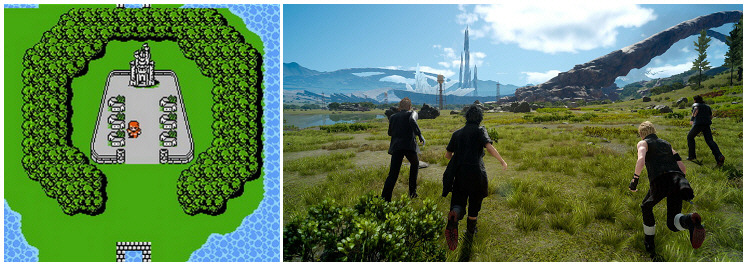
The overworld view in
Final Fantasy on the NES, 1990 (left),
compared with the overworld
view in Final Fantasy XV on PlayStation 4 and Xbox One, 2016 (right)
Final Fantasy XV image
courtesy Gamespot.com
There are strange sights in these games
to be sure, and it will always get sideways looks from the uninitiated.
Square-Enix is a Japanese company, and until now their games were released
in Japan first. Little is done aside from an English translation
to localize the games for the western market. Culture shock, or whatever
it is, aside I've always stuck around for the next game, and I'm not sorry
I have. It's good to be different - 15 games with almost the same
environments and rules every year would get old. Every entry has
a unique battle system and unique story that somehow still feels familiar
to fans and connects with the other entries. If you haven't played
any of them, I still think the best place to start is at the beginning.
I've replayed the original many times across several different platforms,
and still find it entertaining to this day. So put your real life
on hold for a while, and let's hope that it never really is the final Final
Fantasy.
|
By the time everyone reads this, it will be 2017! I hope everyone had a safe and sane holiday season. If my plans hold, it will be a quiet holiday season. I will be meeting some family for dinner on Christmas Eve, seeing Rogue One with a friend sometime after Christmas and watching high school basketball as well. It is low key but a fun way to spend my downtime.
Due to the holidays and other activities, I didn't really have a big subject to write about. However, I did read an article in our local paper that mentioned a San Diego establishment called "Coin-Op Game Room" was opening at new location in San Francisco.
Check out the newspaper article here:
http://insidescoopsf.sfgate.com/blog/2016/04/13/san-diegos-coin-op-game-room-heading-to-san-francisco-this-summer/
Upon my initial read, I didn't realize the article was several months old and that the establishment had already opened. The reviews on Yelp have been mixed so it remains to be seen how this new "barcade" does over the long haul. However, the place is close by my workplace where I could stop by and check it out one day. Alas, I'm not a big drinker and stopping by purely for the video games may be a bit odd. We'll see if I can drag some co-workers there one day.
If anyone in the Bay Area or San Diego has any experience with Coin-Op Game Room, drop me an email. I'd love to hear your experiences and comments to include in the next issue of The Retrogaming Times!
See you next issue!
|
This issue we discuss the most unique controller created for one of the most underrated consoles of the early days. It's the Intellivision controller. The Intellivision was introduced in 1979 by Mattel and was the main competitor of the Atari 2600. One of the slogans of the television advertisements stated that Intellivision was "the closest thing to the real thing." The company tried to create a system that not only was innovative in the games, but also the controller itself. In 2009 IGN named Intellivision as the 14th top console of all time. 3 million units were sold and over 125 games were created in its library. Some of the games were above the competition and made gameplay a lot more fun and the graphics were, to some, better than Atari. For me, the hands down difference in the systems were the controllers. The Atari, as I wrote about in an earlier edition, was as basic as you can get in a controller. The Intellivision, on the other hand was as complex as you can get for a controller. Let's discuss this interesting creation we call the disc control pad.
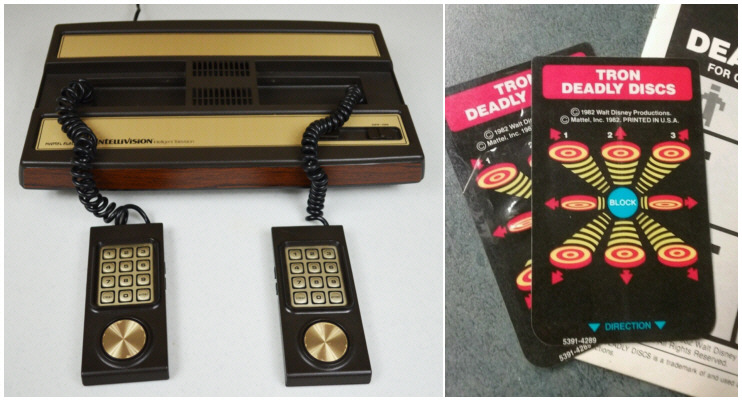
Intellivision "Master
Component" with attached controllers (left), A pair of overlays for Tron:
Deadly Discs (right)
"Master Component" image
courtesy vectronicscollections.org
From the first look of the control pad, it looks more like a computer peripheral than a game console controller. Its rectangular shape and numeric keypad make it unusual at first glance. Then the circular disc shaped control pad makes it even more confusing to the eye. The pad looks like an old-school cell phone with numbers 1 through 9 and the 0 in the bottom middle. The bottom left is the clear button and the bottom right is the enter button. Each game uses the buttons in a different manner. That is where the "sheet" or game "overlays" come in handy. These overlays come with each game and fit nicely into and over the numbers of the keypad to make it easier to understand how to run, jump, shoot or whatever is needed to play the game. For example, in Baseball the overlay will tell you how to pitch, swing or bunt. Plus, it has the fielders position on the overlay to know which one to control. In other games like Tron the overlay tells you which direction to throw the disc and what button is to block. The only thing that is frustrating is if you lose the overlay or it rips and you can't get it to fit in anymore. Then you must use the pad as is and remember or figure out what number does what to play the game.
The control pad or "disc" was a frustrating idea that was hard to get used to with certain games. Growing up with Atari and being able to use the control stick with any game very easily, the transition to the disc shaped controller was difficult. Moving the player around was sometimes hard as well as the more you played the more it seemed like the disc was breaking or sticking in one position. Then there were games that you would want to play for a long period of time, but after a while your thumb would be sore from pressing the disc shaped pad and you would not want to play anymore. Mattel did come out with an attachment that was similar to the Atari control stick, and would go over the disc so you could use it as a joystick. However, that would not last long as the sticky part of that would wear off and the stick would either fall off or come off while playing. It was not the best invention of the time. The thought was there though.
The games I played the most as a kid and have the fondest memories of were Tron: Deadly Discs, Baseball and Astrosmash. These games were advertised as games that would beat Atari in gameplay and graphics. To their credit, in some ways they did for a short period of time. The price tag was a lot more than Atari and the games were not as competitive in the long run. Don't get me wrong, Atari made a lot of bad games, but they did make plenty to choose from. Intellivision only had a handful that were exciting enough to play.
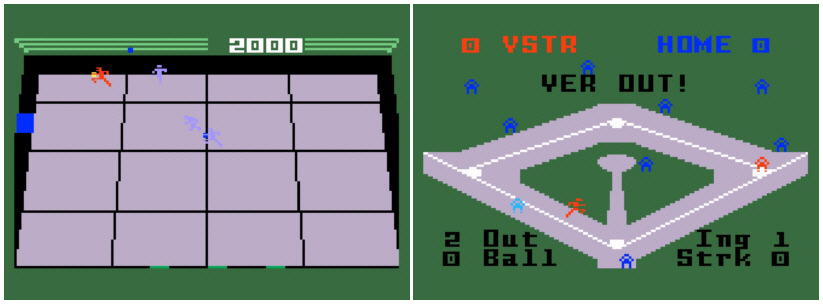
Tron: Deadly Discs (left),
Major League Baseball (right)
The cord was a negative feature in my opinion. It was connected to the system with a curly phone type cord that could not extend very far from the system. I know the world was ages away from wireless controllers, but you would think a cord would be longer and a bit more giving when playing. Especially when in a heated competition and having to have to throw the controller. Just joking.
I must give Mattel some points on creativity. Most companies would not have the courage to create something so different in the beginning of a competitive home console war. Unfortunately, in my opinion, they failed on many counts of trying to be better than Atari and be the future of console gaming.
Overall, Mattel's Intellivision controller
was maybe one of the worst controllers made to date. I may still
plug the system in from time to time and remember the days where the world
only had a few options to play games, and remember how interesting console
gaming was and play some Frogger or Burgertime with the Intellivision control
pad. Next issue we will discuss the highly interesting and once thought
of as the best controller made at the time, the Nintendo 64 controller.
|
Welcome back as we continue our voyage with the CoolBoy Real Game 198 in 1 bootleg Famicom multicart. If this is your first journey with us, a bootleg pirate multicart is a video game cartridge containing multiple games that would otherwise have single cartridge retail releases. Pirate multicarts have become bigger and better over the past couple years. Although these days you have options such as flash memory cartridges if you want to play a bunch of games off a single cartridge, there's just something about these bootlegs that appeal to me. I've found collecting multicarts a fun collecting sub genre since the early to mid 2000's. Two of the currently most popular multicarts are branded under the "CoolBoy" name and are generally known as "198 in 1 Real Game" and "400 in 1 Real Game" and these cartridges are usually sold together as a pair.
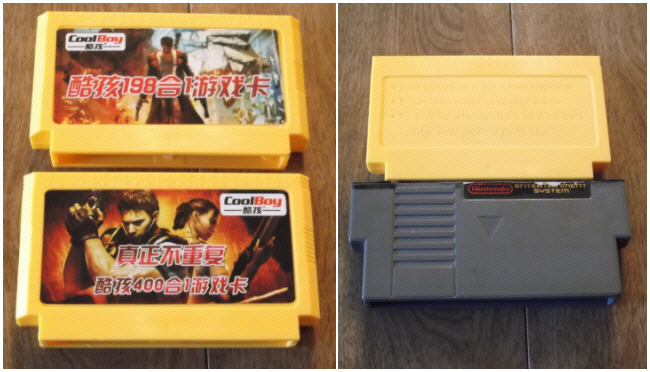
CoolBoy "198 in 1" and
"400 in 1" cartridges along with a custom made Famicom to NES converter
While the 400 in 1 cartridge contains more total games, I find that the 198 in 1 contains a more interesting mix of titles with less filler. This is due to the 400 in 1 cartridge containing more pirate originals including a rather large library of games released by Thin Chen Enterprise, the Taiwanese company better known as Sachen, history's most prolific producer of unlicensed Famicom games. While these games are an interesting collecting sub-genre onto themselves, and a sadly forgotten part of modern NES and Famicom collector culture, they're not necessarily all that fun to play. It should also be said that the back half of the game list for each cartridge is generally filled with these type of Taiwanese and Chinese pirate original games. The 198 in 1 cartridge isn't too bad in this respect, with fifty or so games falling into this category.
This scope of this ongoing column is to quickly evaluate the 198 in 1 cartridge, fifteen games at a time, until the entire list is completed. Additionally each issue will also evaluate a single game from the 400 in 1 cartridge that does not appear on the 198 in 1 counterpart. For the entire duration of this column, each cartridge will be played on an original toaster-style North American NES console. To convert the bootleg Famicom cartridges for play the NES, I will be using a Famicom to NES converter cartridge built from parts out of an early release copy of Gyromite. As a final note, many of the games contained on these bootleg cartridges have their title screens altered to strip away any copyright dates or the like.
Now, back on to high seas and high excitement!
The fifteen games featured in this issue
bring us back to a simpler time on the Famicom. This includes early
titles published by Nintendo that served to establish the Famicom in Japan,
with many becoming the original "black box" launch games in the United
States. There are also a couple arcade conversions, a very popular
Nintendo puzzle game, an even more popular multi-platform puzzle game,
and one of the most important and influential video games of all time.
Here we go.
CoolBoy Real Game 198 in 1, Games 61 - 75:
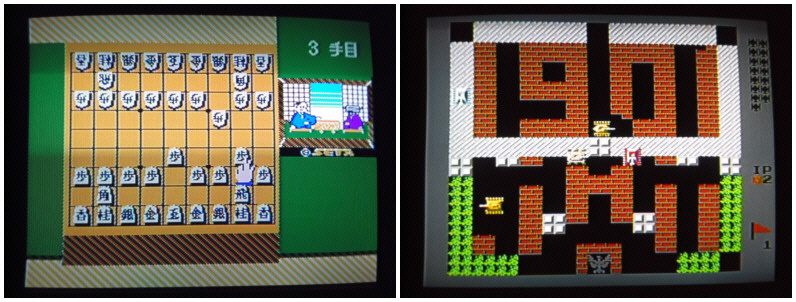
Hon Shougi 9 Dan Shougi
Hiden and Tank A 1990
061. Naitou - As mentioned with game number 059 on the list, Mahjong, this is another game that fits into the category of Famicom games that are difficult for a Westerner such as myself to properly examine. Hon Shougi Naitou 9 Dan Shougi Hiden is, as should be clear by the title, a shougi game. Shougi can be roughly considered the Japanese equivalent of chess, as both games originated with the ancient Indian game chaturanga, which then spread to the East to become shougi and to the West to become chess. Shougi games are outrageously popular on Japanese home consoles and computers, although not quite as prevalent as games based on mahjong. I don't play shougi myself and know little of its rules so I'm not going to be the best judge of a shougi game's merits or failings but this game, developed by Seta, has a little personality at least. It features a few different starting modes, which I believe vary the board set up as well as which player makes the first move. The board and shougi titles are nicely drawn and easy to read, if you recognize the characters that is. Rather than a human opponent, you play against a robot complete with a mechanical claw that moves its pieces. This bit of whimsy is carried a little further in that both you and your robotic opponent are shown, dressed traditionally, on the right side of the game board in a little window. Both characters have a bit of animation shown in the window as moves are made and the game progresses. I can't judge whether or not this is a good shougi game in terms of computer A.I. but if you like shougi then this one is worth a try as it's pretty interesting visually.
062. Tank 90 - One most common, if not the single most common, game you find on a Famicom multicart is Tank A 1990, a Chinese bootleg rework of the 1985 Namco game Battle City. There were a few different flavors of the Tank 1990 bootleg, featuring different level layouts and game modifications. While Battle City featured a construction mode that allowed for creation of custom level layouts, the Tank 1990 games built upon custom stages by also modifying game rules and remixing power-ups. Battle City was itself an expansion of the 1980 arcade game Tank Battalion; a tremendously influential yet widely overlooked early Namco arcade release. Battle City plays a lot like Kee Games / Atari's much earlier series of Tank games, with an emphasis on defense rather than pure offense. Each stage occupies a single screen comprised of brick walls that can be shot through, steel walls that require increased firepower to destroy, water that serves as a movement barrier, jungle that can be hidden under, ice that causes delays in stopping and turning, and blank areas that present no adverse effect. Enemy tanks appear on the screen and roll out, with more steadily appearing over time. The main objective to complete a stage is to destroy all enemy tanks but there is also a secondary objective that reveals the genius of Battle City's game design. Located at the bottom of the screen is the player's base. Although the player begins with extra tanks in reserve, if the base is destroyed then the game is over. Even if there are still reserve tanks, even if the base is destroyed by friendly fire, if it gets hit - that's the end of the game. While this may all seem simple on paper, the enemy tanks play to win and can swarm the base in an instant. This means a tremendous amount of fast reaction strategy is required to last more than a couple of minutes in Battle City. Destroying a flashing enemy tank will cause a power-up icon to appear in the level. These can award anything from an extra life, to an offensive power upgrade, to a temporary defensive boost to the walls around the base and more.
The hack here, Tank A 1990, features 50 all-new new stages over Battle City's original 35. Some of these are a little messy in design but all of them can still be completed and with a game like this there is no shame in extra levels to challenge. Two-player mode is the way to go as this game is infinitely more fun with a friend and requires quick communication to formulate a battle strategy and avoid becoming a victim of friendly fire. Overall the levels here are more difficult than those in the original game as more powerful enemy tanks are introduced immediately, making it feel like Battle City for seasoned tank commanders. It's very easy to become so distracted on the offensive that the enemy forces will converge on the base before you even realize it. This is especially true when making a run for a power-up.
It has been my impression that people really hate this game and consider it a huge throwaway on these multicarts, often saying the game is simply boring. Even the original game has this reputation outside of Japan. I think this response is due to such a simple looking game being so demanding and difficult in reality. I will say that the Tank 1990 bootlegs are far more punishing than Namco's original game, so if this is where you are starting out then there is definitely a high difficulty curve. If you give this game a try and find it too difficult to get started, then I suggest playing the original Battle City and coming back to Tank A 1990 when you're more battle-hardened and looking for a fresh challenge.
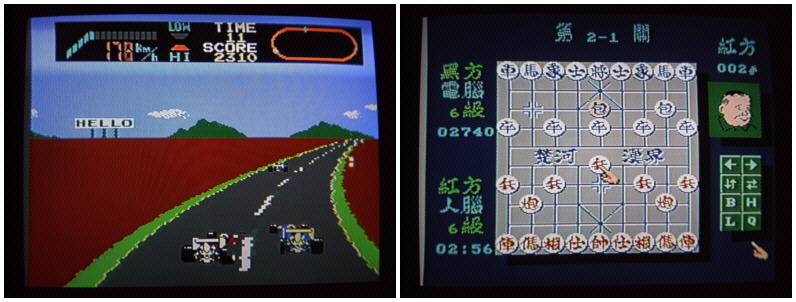
F-1 Race and Chinese
Chess
063. F1 Race - Here's an interesting early Famicom game that never made it out of Japan. F-1 Race is Nintendo's take on Namco's arcade classic Pole Position, which was released to arcades two years before F-1 Race in 1982. F-1 Race really does wear its influences on its sleeve as nearly everything about the game is a direct lift from Pole Position. Aside from the basic concept of a behind-the-car timed racer, the music is extremely similar to Pole Position, even dancing on the edge of being directly remixed. The title screen theme sounds quite a bit like the Pole Position high score fanfare, except played at an increased tempo. The race introduction fanfare also sounds strikingly similar to the Pole Position audio cue that plays after the coin-up sound. The similarities don't stop once the race begins, as F-1 Race plays impressively smooth with dynamic control both in terms of steering and speed regulation. It becomes second nature to weave through traffic, speed through corners right on the edge, and quickly shift between low and high gear. As home versions of Pole Position go, both officially licensed and clones, F-1 Race is easily one of the best controlling ever released.
While Pole Position was a universally praised game, and home conversions would continue to be released right up through the modern era, Nintendo elected not to include F-1 Race along with the "black box" NES launch titles in North America. There is some speculation as to why this didn't happen but my take is that without a name like "Pole Position" attached to it, this would just be looked at as another simple racing game. World Grand Prix on the Sega Master System is a really good Pole Position clone as well but no one remembers that game either, as there isn't any name recognition. Every "black box" release was selected to fill a specific role in the launch of the NES hardware in the United States, and the racing spot was already taken by Excitebike, a game many would agree was a much better choice. Once the second series of first-party published NES games came around, Nintendo wisely chose to publish Square's Highway Star as Rad Racer in North America, just two months after its Japanese release by Square in 1987. Rad Racer is a much more modern and impressive looking game, a Famicom take on another much more modern and impressive looking arcade game - Sega's Out Run from 1986.
A lot of classic arcade games fell victim to similar gaps between Famicom release and NES popularity, including many Famicom conversions of Namco games such as Dig Dug, Mappy, Galaxian, and Pooyan. While F-1 Race is well designed and a lot of fun, it is also extremely simple. Fine for a quarter a play but not really the title you'd want to push as part of the revival of home video games in the United States, especially without a recognizable brand like Donkey Kong. Nintendo wouldn't let the technical prowess of F-1 Race go to waste in North America however, as they would build a much more complex game upon its basic design. That game would be Mach Rider, released as a "black box" title in 1985, and included on this multicart as game number 071.
064. Chinese Chess - Somewhat fitting as we opened this time with a shougi game, this is a pirate original version of the board game Chinese Chess, also known as Xiangqi. What's interesting about the game included on the multicart is it seems to be a hacked bootleg of an original unlicensed game developed by TXC Corporation. TXC Corporation was a Taiwanese company whose primary business was manufacturing bootleg Famicom clone hardware under the Micro Genius brand name. In addition to bootleg hardware TXC Corporation also developed, manufactured and published games. It also seems that TXC Corporation acquired another Taiwanese developer, Idea-Tek, in the early 1990ís and re-released their titles. Some of these terrible Idea-Tek developed games made their way onto the NES, published by unlicensed publisher and developer American Video Entertainment: F-15 City War, Puzzle, Rad Racket, and Venice Beach Volleyball. See, these Taiwanese bootleg companies had products right under your nose for years and you didn't even know it!
Chinese Chess was one of TXC Corporation's earliest, if not their very first, unlicensed Famicom game. The version included on the multicart is not TXC Corporation's game untouched, but rather a bootleg hack that does to their game what many bootleggers did to officially licensed titles. While the game is the same, the title screen has been stripped down and some of the opponent graphics have been reworked slightly. While it is not unheard of for one pirate outfit to rework another pirate outfit's games, the minimal effort put toward the changes is a little puzzling. It's almost as if whoever bootlegged the game got bored with it after playing around with the opponent portraits a little, said "That's good enough," and moved onto something else. As with shougi, I don't play xiangqi and can't say one way or another if the game plays well or how good the computer opponents are but as a game like this goes, the production values are at least decent.
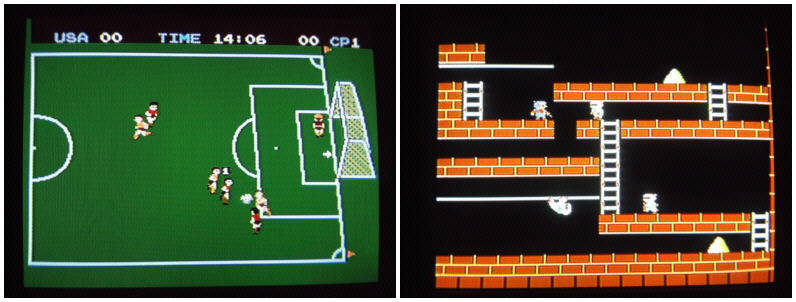
Soccer and Lode Runner
065. Soccer - An early game for the Famicom and the NES, Soccer is a basic sports game that is precisely what one could expect to see along side new home video game hardware in the 1980ís. The difference with this game, as with all these early Nintendo published sports titles, is it looks a lot more impressive than the home sports games that came before it. The player sprites are fairly detailed and quite large with some varying animation, the field lines are solid and don't flicker, and it's easy to discern which player you are controlling. The A Button shoots toward the opponent's goal, with a controllable arrow to denote the precise angle of the kick. The B Button is used to pass the ball to the closest available teammate, indicated by a flashing arrow above their head. This is decided automatically, taking into account the direction the players are facing and their proximity to one another. This creates a little bit of rigidity within the controls as it prevents freely kicking the ball in any direction or having complete freedom over which teammate to pass to. Player movement and ball dribbling feels predictable and the ball has a good sensation of free movement, rather than feeling locked from one player to the next. A rather jaunty musical accompaniment plays in the background throughout the match, not incredible but certainly not annoying. The game also features a reasonably cute little half time show with cheerleaders that dance around on the field, something that many other Famicom sports games would later feature. The whole game feels solid, but not exceptional, and if Soccer has one failing that's where it lies.
At the time of its release in Japan in 1985, and even in North America in 1987, Soccer was easily one of the best home console soccer games. It played a simple but technically competent game of soccer and at the time that was a bit of a rarity. However as smoothly playing as it is, the game itself is very plain. Sure the player sprites are fairly large but there's really only one of them used to fill out both teams, with some small changes made for the goalkeepers. In fact the cheerleader sprites are really the only other character sprites to be seen. It may have seven different teams to choose from but they amount to little more than a change of uniform color. Five adjustable difficulty levels and adjustable match times allow for a little bit of customization but really amount to the bare minimum of what one would expect. Although it should be said that the single player CPU opponent is surprisingly serviceable for a game of this vintage, as a two-player game there's a lot more value here. While it is more impressive than the console soccer games that came before it, Soccer looks very plain compared to many other contemporary releases, both on the Famicom and NES. Games like Donkey Kong, Duck Hunt, Mario Bros., Balloon Fight, and Excitebike were all released before Soccer, so it's easy to see why this game didn't make a huge impact. This game also has to have the worst NES "black box" artwork of the entire series, which I suppose depicts the two goalkeepers having a kick fight, while the most amateurish rendering ever created of a soccer ball flies overhead. When the garbled sprites that make up the ball in the game look more realistic than the pixilated box art, you know you have a problem. No wonder I can't remember anyone ever owning this game years ago.
066. Loder Runner - Of the games included on this journey, Lode Runner is the one title that can be considered a true classic of an era from before the Famicom. Created by Doug Smith and originally released by Broderbund in 1983 for the Apple II, it quickly became one of the most popular computer games of its day and was ported to a myriad of different hardware platforms. The objective of Lode Runner is extremely simple: collect all the gold in a multi-story level comprised of ladders and bricks while avoiding guards that patrol and give chase to the player. While the objective is simple, completing it is anything but. The player cannot jump and can only gain height by climbing ladders. He also has no method of attacking the guards. His only defense is the ability to dig holes into ground immediately to his left or right, which a patrolling guard can fall into. Once a guard is trapped, he can be safely stepped over. If a trapped guard is carrying gold, he will drop it and the player can then recover it. Some stages have gold that can only be collected by tricking a guard into picking it up and getting trapped, then freeing the guard and later trapping him again so the gold will be dropped in a reachable place. While guards can climb out of holes they fall into, the same cannot be said for the player, so advanced planning must be taken into account when digging passages to avoid becoming trapped. Eventually holes will fill themselves in and any guards crushed in a backfill will reappear at the top of the screen. Once all the gold has been collected the player must climb to the top of the screen to complete the level.
Although it was ported to computer platforms in the region, Japan's mainstream taste for Lode Runner really began when Irem acquired the rights and created a version for Japanese arcades in 1984. The arcade Lode Runner games would prove to be extremely popular and spawn a number of sequels. Virtually every company that acquired the rights to the game would redesign its look to better fit with the expectations of its respective hardware and region of release. When Hudson Soft acquired the rights for a Famicom version that same year they were no exception, and completely overhauled the game's graphics to make better use of Nintendo's hardware, including a redesign of the player and guard sprites. This was only Hudson's second Famicom game and it proved to be a massive success, going on to become one of Hudson's biggest selling games of all time. As with Irem's arcade Lode Runner series, the Hudson Famicom release touched off a mania for the series on home video game hardware, with Irem returning to helm two popular sequels on the Famicom Disk System. Broderbund later published Hudson's Famicom version on the NES in 1987 and that is the version included here on the multicart.
The NES / Famicom version features fifty levels and was technologically a big step forward for Famicom games. Lode Runner could be considered the first Famicom game to feature music beyond the short incidental tunes of the games that came before it. It was also the first Famicom game to have screen scrolling directly controlled by the player's movements and the first Famicom game to feature bi-directional scrolling. It was also where Hudson's most well known mascot was first properly realized. The guard sprites for Hudson's version would later be used for the player character in the Famicom version of Bomberman, released a year later in 1985. The Famicom version of Bomberman actually directly links the two games by showing Bomberman become Runner at the game's conclusion. This design of Bomberman, the stubby little robot with the antenna helmet, would become an instantly recognizable symbol of Hudson Soft in the years that followed.
I guess some readers are going to be calling for me to hand in my retrogamer card when I reveal this, but I really don't like Lode Runner. While I tend to love action puzzle games, Lode Runner was a little too before my time and I've never been able to go back and get into the series. Of course most Lode Runner games assume you have an ironclad understanding of the game mechanics, its tricks and misdirections, and are looking for an even greater challenge than the previous incarnation. This can make entry difficult for newcomers, especially given that it's a series that began over thirty years ago, with each game generally building on the challenges of the last. The hallmark of Lode Runner is a simple set of rules used to create a ridiculously devious level of challenge. The Famicom / NES release of the game is a good place to begin if you're interested in the series but after a few minutes Lode Runner begins to make my head hurt.
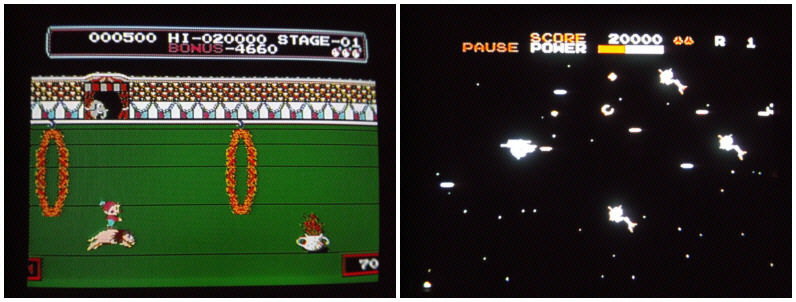
Circus Charlie and Choujikuu
Yousai Macross
067. Circus Charlie - Here's one I really like, a home release of Konami's 1984 arcade game Circus Charlie. Although I never played Circus Charlie in arcades in my youth, this title is an undeniable classic from the height of Konami's early arcade days. Charlie must complete a series of circus acts, earning points along the way and bonuses depending on how quickly he finishes each performance. Although some variation is introduced as each set of circus acts are completed, the six performances that Charlie must complete are: jumping through flaming rings atop a lion, jumping over monkeys while walking a tightrope, crossing a series of trampolines while avoiding dangers, jumping across a series of giant balls while balancing atop them, bouncing across springboards while riding atop a horse, and finally crossing the big top on the swinging trapeze. While the game looks simple, almost juvenile, and is based heavily on repetition, a well-refined skill set of precise control and timing is required to do well in Circus Charlie.
For the 1986 Famicom home conversion the third act, jumping across elevated trampolines, was removed. I assume this was done as it is the event with the most objects on the screen, featuring fire breathers and knife throwers to jump over, as well as an alternate backdrop that has the entire circus act taking place over water complete with jumping fish to avoid. The conversion of the other five acts to the home hardware is done nicely, not as colorful as it could be or was in the arcade, but by no means at all poor. The game plays well and although Circus Charlie used a vertical screen aspect in arcades, the horizontal aspect of playing the game at home feels much more appropriate. The change in aspect does create the odd sensation that the game is moving slower than it did in arcades however. Some of the animation is missing but it all pertains to things not essential to gameplay, such as Charlie doing a flip to land on ending platforms or monkeys holding up bonus point award signs. The bonus secrets are not present as well, things like pressing the button at the end of the tightrope to reveal bonus money. As with the missing animations these are not essential to the game but went a long way to give it more spice and personality. The arcade audio is also decently recreated and sounds as it should. It's not an incredible arcade conversion by any means but is quite serviceable and is easily one of the best Famicom games that Soft Pro ever developed. This is also a really common game to find on most Famicom multicarts, even if they do tend to title it as "Circus Chablie" due to the stylized font used on the title screen.
068. Macross - While there would be a few great home and arcade shooters based on the anime and multimedia sensation Macross, this first Famicom outing is a rather standard and uninspired affair. Choujikuu Yousai Macross (The Super Dimension Fortress Macross) is a horizontal shooter that puts the player behind the controls of a VF-1 Valkyrie variable fighter, essentially a space-capable fighter jet that is able to transform between three different modes, allowing it to fulfill multiple roles in varying combat environments. The Macross animated television series is a vast space opera that goes well beyond the scope of this column but it must be said that it was, and still is, ridiculously popular in Japan and abroad. Some readers may know Macross better as the show that was heavily reworked and adapted by American writers into the first third of the Robotech television series.
Licensed games rarely turn out well, especially those of this vintage, and there's no exception here. Rather than build a shooter around stages of varying design, differing visuals, interesting bosses, challenging enemy patterns or any of that stuff that makes a fun game, Macross is instead built upon repetition. Fly though endless waves of seemingly randomly dispatched Zentradi battlepods and ships, fly into a Zentradi battlecrusier, destroy the reactor at its core and then do it all over again... and again... and again. Even with the repetition, some attempts were made to utilize the Macross license and there are small sparks of game design here and there. As an example the VF-1 Valkyrie can be taken through its three modes by holding down the A Button and pressing Right (Fighter), Up (GERWALK), or Left (Battroid) on the control pad. While Fighter mode scrolls the screen the fastest, thereby speeding through the level, it has very slow ship movement and the B Button must be pressed continuously to fire. GERWALK mode slows the screen scrolling a little but allows faster ship movement, as well as rapid automatic firing of the canon as long as the B Button is held down. Battroid mode slows the screen scrolling even more and makes the VF-1 a larger target but features the same rapid firing as GERWALK mode. Battroid mode also allows even faster movement around the screen along with the ability to turn around and fire to the left. A swarm of homing micro-missiles, a trademark of the Macross series, can be fired by pressing the Select Button as long as there are a pack of them in reserve.
Some of this may sound pretty good but it's the endlessly repetitious gameplay that kills any fun that may be had. Battles take place with the same generic stars and explosions space backdrop while outside and the same drab gray interior during each battlecrusier sequence. For an anime series that was so visually interesting, this is a real shame. Even the music is built on extreme repetition. At the start of the game a little animation of Lynn Minmay walks across the screen and strikes a gong, leading into a rendition of her song "Shao Pai Long," a very well known piece of music from Macross. The Famicom rendition of the song sounds pretty good but it plays endlessly throughout the rest of the game, only stopping for a moment when your Valkyrie is destroyed or a level is completed. This gets very annoying very fast and only helps to heighten the sense of pointless repetition this game exudes. Interestingly that little animation of Minmay is right out of the anime series, as it's the introduction to a Valkyrie combat arcade game shown in a game center on the Macross. I suppose that's a nice touch and while the game does progressively become more difficult, the increase in difficulty amounts to little more than throwing more enemies across the screen. This one is for Macross fans only and even then don't expect much substance.
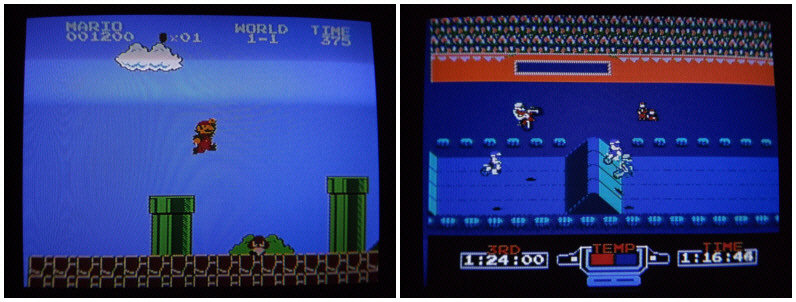
Super Mario Bros. and
Excitebike
069. Super Mario - What can be said about Super Mario Bros. that hasn't already been discussed to death? It's easily the most impressive game to use standard Famicom hardware, before all the shiny new memory mappers and other expansion chips were introduced in cartridges, designed to constantly breathe new life into aging hardware. I give Shigeru Miyamoto a lot of flack for the credit and admiration thrown at his feet for game concepts he didn't wholly create but you know what, Super Mario Bros. is the real deal. Side scrolling games and early platforming games had existed before, most importantly Namco's Pac-Land from 1984, but Super Mario Bros. is the game that fully realized the concept of a side scrolling platform game. Solid controllable physics, a steadily increasing challenge based upon skills leaned through experience, hidden secrets, power up items that both increase offensive power while adding defense at the same time, collectibles that have purpose beyond simply earning points, and a concrete structure of progression - it all came to reality with Super Mario Bros. All one has to do is play some of the terrible platforming games on the Famicom, that were released directly in the wake of Super Mario Bros., to see how amazingly well designed Nintendo's game is. Mario's weight and momentum, the notion of knowing what to expect in terms of control as he runs and jumps through a stage, simply cannot be taken for granted during this era of gaming - because it simply was not standardized until Super Mario Bros. was released.
So, Super Mario Bros. on the multicart, great! That's always a welcome title to see and a core game of the platform. However there's this little problem. As with game number 023 on the cartridge, Ninja Gaiden, the version of Super Mario Bros. included on the multicart is the European PAL optimized version. To counter refresh rate differences between the North American and Japanese NTSC 60Hz standard, and the European PAL 50Hz standard, some European games were slowed down by 16.7% to correct timing problems. Playing one of these games on NTSC hardware has the opposite effect of running the game 16.7% faster. This is a common problem with some games on these pirate multicarts and can lead to disappointment as it can make a game difficult or impossible to play. Super Mario Bros. at increased speed isn't very fun, teetering on unplayable to be honest. At the very least this is probably the most common NES game out there (other than Bases Loaded, I swear, everyone had two copies of that game) so it's otherwise easy enough to find and play.
070. Excite Bike - As mentioned when discussing F-1 Race, Excitebike was the title Nintendo chose to fill the requisite racing game slot in the launch lineup for the NES. This decision meant that Excitebike was released among the same assortment of titles both in Japan and the United States, and unlike F-1 Race it had an arcade counterpart to give it an extra boost of recognition in both regions. Excitebike is a side scrolling motorcycle racing game, sometimes referred to as a belt scroller due to how the track endlessly loops from the right side of the screen to the left, as if the game takes place on a continuous belt. As with F-1 Race the objective isn't to win races against opponents but rather to complete courses within set time limits. There are two modes of play, with one featuring computer controlled motorcycles that serve as traffic and the other as a solo affair, but the objective in both is to finish under the third best time or better.
The player's motorcycle is permanently positioned on the left side of the screen but can be moved vertically up and down the track. Left and Right on the directional pad control the rider's weight transfer on the motorcycle, allowing for pitch control when catching air after riding over a jump. Proper pitch when cresting hills, jumping off them, and subsequently landing is an extremely important aspect of keeping the motorcycle upright and its speed up. The motorcycle has two throttle speeds, regular and turbo, controlled by holding the A or B Button respectively. The turbo throttle expectedly has greater acceleration but also increases the motorcycle's engine temperature to dangerous levels, as indicated by a gauge at the bottom of the screen. If the temperature redlines then the rider will pull over and wait until the engine cools down before resuming the race, loosing valuable time in the process. Basic Excitebike strategy dictates climbing and cresting hills at top speed with optimal pitch and a smooth landing for the best lap times. This not only requires careful management of motorcycle speed and engine temperature but also a precise awareness of how to hit each hill and jump on a given course. This makes Excitebike is a pretty involving game both then and now. Even with all its complexity, Excitebike is still a very approachable game due to its smooth controls and easy to comprehend objectives. There's also a very intuitive and enjoyable course design mode that allows creation of a customized track to race on. Next to Super Mario Bros. this is the NES "black box" game I'd assume most people played and owned regardless of when they picked up the hardware.
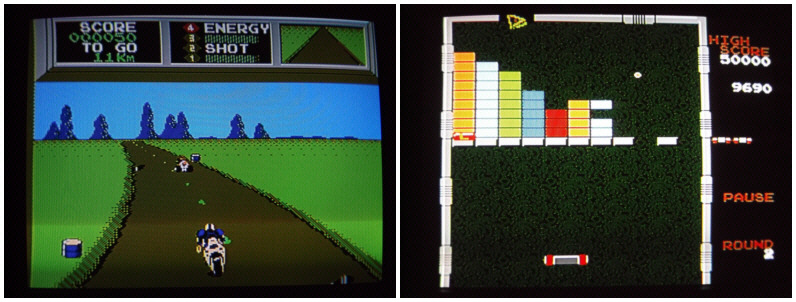
Mach Rider and Arkanoid
071. Mach Rider - Although Excitebike was chosen over F-1 Race to fill the lone traditional racing game slot in the NES launch lineup, Nintendo wasn't about to let F-1 Race's technical competence stay exclusive to the Famicom. A more action-focused original title was built upon the basic design of F-1 Race, increasing both the complexity of the game and the demands it placed upon the player. The result of this change in direction is Mach Rider, a loose combination of the Mad Max films and Kamen Rider television franchise. In the year 2112 the Earth has been invaded and ravished by evil forces. As "Mach Rider" the player rides from sector to sector on his motorcycle searching for survivors and fighting for survival with a machine gun. The game features two main game modes: Fighting Course and Endurance Course. Fighting Course is a series of ten stages with two paths to choose from in each. This mode also features brief text interludes at the start of each stage that detail the game's story as progress is made. Endurance Course requires Mach Rider to travel a set distance within a specific amount of time. Unlimited lives are granted in this mode but crashing robs Mach Rider of valuable time. The Endurance Course can also be challenged without any enemies in a mode called Solo Course. Similar to Excitebike, there is a design mode that allows creation of a custom track.
While this may sound like F-1 Race with a weapon, the differences lie in the blistering speed and increased control complexity. Mach Rider runs quite a bit faster than F-1 Race, to the point where the smooth animation exhibited in the earlier game can actually become a little jerky. Rather than a simple high and low gear two-speed transmission, Mach Rider's motorcycle has four gears to deal with. The roads are also in terrible shape and littered with debris and other obstacles, not surprising for a game with a post-apocalyptic theme but a definite challenge to drive through. There are also enemy bikers that must be destroyed or avoided. That's the biggest challenge in the game - to simply avoid being rear-ended by the enemy bikers. Moving any slower than top speed will cause enemies to zoom up on Mach Rider's tailpipes in an instant, requiring an increase in speed to leave them in the dust or a quick dodge to let them by. Speeding up is usually the best decision as knocking enemies off the road can be pretty dicey. The trade off is that increased speed makes dodging obstacles and negotiating turns exceedingly difficult. Third gear is just a little too slow to get away from enemies while fourth gear is just a little too fast to comfortably ride, requiring constant speed adjustments just to survive. While I can't recommend Mach Rider as a great game due to its punishing difficulty, it is worth checking out as it looks ahead to games such as Atari's RoadBlasters.
072. Arkanoid - The grand evolution of the wall-breaking genre of games that began with Atari's Breakout, Taito's Arkanoid takes the old ball and paddle game and infuses it with modern game design sensibilities. The paddle in Arkanoid is actually a ship, the Vaus, which escaped from the titular Arkanoid, its doomed mothership. With this science fiction theme as a backdrop, Arkanoid expands upon the basic concept of knocking a ball into a wall of blocks, by adding collectible power-ups similar to what was being seen in shooters of the time. Destroying blocks will occasionally yield a lettered capsule that will tumble down the screen. Collecting the capsule will award power-ups that can expand the length of the Vaus, allow the ball to be caught and released at will, split the ball into three, transform the Vaus into a laser cannon that can shoot the blocks above, slow ball movement, award an extra life, or even open an instant exit to the stage. Once all blocks in a stage are destroyed the Vaus moves onto the next. Floating objects are also slowly released into each stage and although they are easily destroyed with the ball or the Vaus, they often cause unexpected ricochets that can be difficult to predict. At the end of the game the player faces off against a giant moai head, the antagonist of the Arkanoid series, DOH. Unsurprisingly DOH must be defeated by repeatedly bouncing the ball against him. Arkanoid revived the ball and paddle game and was successful enough to spawn multiple sequels both in the arcade and at home. The NES version is a faithful recreation of the arcade title right down to being packaged with an analog paddle controller both in Japan and the United States. Honestly the paddle controller is a must for this game, as although it can be played with the directional pad, the same level of control and speed simply cannot be obtained with a standard controller.
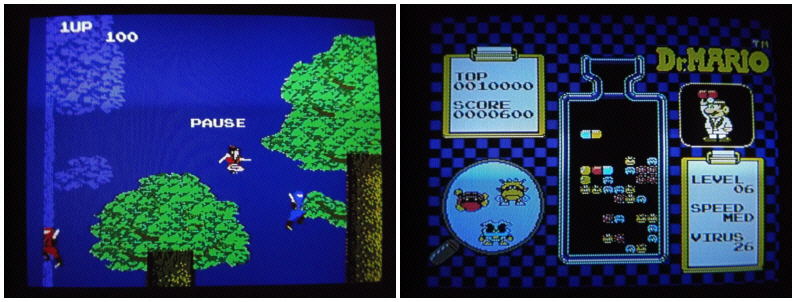
The Legend of Kage and
Dr. Mario
073. Legend of Kage - A fun and sadly forgotten title from Taito, The Legend of Kage was a game that I didn't see much in arcades but always found in the NES collections of friends and on rental store shelves. Kage, a ninja from Ida Village is tasked with rescuing Kiki, daughter of the Shogun. Armed with a pair of short swords and an unlimited supply of throwing shuriken, Kage sets off to the mountain fortress where Kiki is being held. The swords can be used both offensively as well as defensively, allowing Kage to deflect enemy shuriken and protect himself. However Kage's greatest asset is his extreme agility, including the ability to leap to great heights and climb effortlessly. If one thing is remembered about The Legend of Kage it's the insanely high and fast jumping through the opening forest area. The game is built around four areas including the forest, a water-filled passageway, a long climb up the fortress wall, and infiltration of the castle itself. After completing the four areas, Kage will free Kiki and the couple will make a daring jump from the roof of the castle to the forest below. As they flee, Kiki is captured once again which leads into a boss fight. After defeating the boss, the game begins again during another season. While the arcade version only featured two seasons to complete, the NES version adds a third season, effectively adding on a third loop to complete a run of the game.
The NES version also adds a new power up system in the form of crystal balls, which defeated enemies sometimes drop. Collecting a crystal ball will change Kage's clothes from red to green and enlarge the shuriken he throws, making enemies easier to hit. Collecting a second crystal ball will change Kage's clothes from green to orange and give him a speed increase. However the most useful effect of the crystal ball is that it allows Kage to take a hit without dying. In addition to the crystal balls, there are also special forest monsters that sometimes appear and grant special tricks once collected. The most powerful of these allows Kage to throw shuriken in all eight directions simultaneously. However this special power can also make Kage complacent and it's not uncommon for an enemy shuriken to slip in and catch him amongst the carnage. While it's not the deepest video game it is extremely addicting, well designed, and a joy to play. The NES version is the one included on the multicart, which is the same as the Famicom release except it has an English title graphic.
074. Dr. Mario - If there was one puzzle game that Nintendo ever tried to push hard into the Tetris demographic it was Dr. Mario. Rather than having a handful of pieces that are different shapes as in Tetris, all the pieces in Dr. Mario are of the same shape but varying colors. Rather then Tetrisí tetrads (or tetrominoes as they're called now), Dr. Mario's pieces resemble two-piece medical capsules. Each capsule is made up of halves consisting of red, yellow, or blue in any combination, including two halves of the same color. Dr. Mario flips the capsules into a jar filled with correspondingly red, yellow, and blue viruses. If a horizontal or vertical chain of four or more of the same color is completed it will disappear. Any viruses contained within the chain of the same color will be eliminated. The objective in each level is to eradicate all the viruses in the bottle before it becomes overfilled with capsules.
While it seems like a simpler concept than Tetris, Dr. Mario can be extremely difficult with higher virus densities and capsule drop speeds, as it often seems the game can deal the player an unwinnable scenario. The version included on the multicart has an issue where the viruses in the jar are not animated. While the game still plays fine and all the viruses originally did was flicker between two frames of animation, the lack of that small animation makes the game feel a little flat and dead. All I can think is that in the process of removing the Nintendo copyright on the title screen something in the game's code was broken to halt the virus animation. It's a bit of a shame as that little change feels as if it takes a lot away from the experience as a whole.
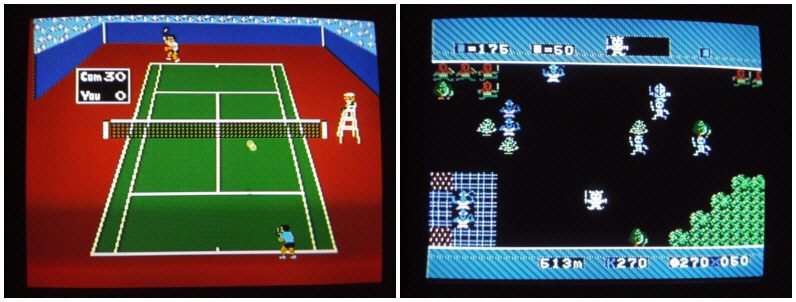
Tennis and Bokosuka Wars
075. Tennis - Although another early sports contemporary of both the Famicom and the NES, I find Tennis a much more enjoyable game than Soccer. This shouldn't be all that surprising, after all tennis is really where video games began, in the 1950ís with simple back and forth tennis games on oscilloscopes. Then of course Pong giving both arcade and home gaming its first true craze, although it wasn't the first video game in either environment. Nintendo's Tennis looks and plays like a modern expansion of Activision's Tennis for the Atari 2600, released three years earlier in 1981. Both games feature a television-style view of the court from a behind the player perspective, providing a realistic sense of depth. Where Activision's game essentially stretched Pong into this perspective and put reasonably proportioned players on the court rather than paddles, little else about the genuine game of tennis was represented. All shots would clear the net and it was impossible to hit the ball out of bounds.
Nintendo's Tennis on the other hand features
a court with properly drawn service lines, a net that has vertical height
to it, out of bounds areas, a backdrop resembling a professional area,
and even features Mario as the chair umpire complete with speech bubbles
denoting his calls. Serves must be carefully placed into the correct
service court and the ball nicely scales as it moves back and forth during
play. The A Button performs a standard swing while the B Button lobs
the ball. When used in combination with directional movement, depending
on what side of the player the ball is on, a handful of different shots
can be performed. Although there is a two-player mode, it is doubles
against a pair of computer opponents. The lack of a player-versus-player
mode is really this game's only failing. However as an early single-player
or cooperative two-player Tennis games go, this one is very well designed
and still quite fun to play. The computer opponent's difficulty level
can be adjusted and while the lower difficulties are good to learn the
game, the higher levels put up quite a battle and add in some replay value.
CoolBoy 400 in 1 Real Game, Spotlight Selection:
289. Bokosuka Wars - If you've made the voyage this far then I'm sure it's quite apparent that I have a rather eclectic taste in video games. Well the selection on the 400 in 1 cartridge this time is a game most people really hate. Bokosuka Wars has actually been described by some as one of the worst Famicom games of all time. I think that's a little harsh but I can admit that Bokosuka Wars is a game that stacks the deck firmly against the player and comes out of the gate wanting to crush their soul. Originally released by ASCII in 1983 for the Japanese Sharp X1 computer, Bokosuka Wars was the first tactical RPG in Japan, if not the first true realization of the genre ever created. The objective is to lead King Suren and his forces across an expansive battlefield to defeat King Ogereth in his castle on the other side of the land, all in real time. Ogereth's forces are massive in number, literally hundreds upon hundreds of enemies between the starting point and his castle.
Bokosuka Wars was very popular on Japanese computers and in 1985 it was released on the Famicom with a few gameplay tweaks. While the earlier computer versions started King Suren off with a decent sized army at the beginning of the game, the Famicom version begins with King Suren alone. For this outing King Ogereth has captured King Suren's forces and imprisoned them in trees and rocks. King Suren can free his forces by touching a tree or rock that contains an imprisoned man but there is no way to ascertain which terrain objects contain captured forces. Additionally each play randomizes which objects have soldiers trapped within, so it is very possible to have one game with friendly forces everywhere and another where King Suren roughs it alone for most of the adventure. The forces that can be found come in two classes: soldiers and knights. If they survive a few battles, soldiers will be upgraded to slightly more powerful ninjas, while knights will be upgraded to slightly more powerful golden knights.
Movement is one of the many unique and interesting aspects of Bokosuka Wars as rather than moving individual units, entire classes move at once. An indicator at the top of the screen shows what class is currently selected: all forces, King Suren alone, soldiers and ninjas, or knights and golden knights. If only King Suren is selected then he alone will move in response to the directional pad. If the soldier icon is selected then all the soldiers and ninjas will move together in response to the directional pad. If the knight icon is selected then, you've guessed it, all the knights and golden knights will move together in response to the directional pad. If all three icons are selected together then the entire army, King Suren included, will move together in response to the directional pad. Movement is along a grid and isn't particularly precise, especially when moving a large force, so it should be considered more of a suggestion to move in the desired direction. It's also easy for King Suren's forces to get hung up on terrain or to get the different classes bunched up behind one another, making specific tactical movements difficult. Corralling your forces and keeping their ranks cleanly sorted is a big part of the strategy to doing well in Bokosuka Wars.
When one of King Suren's units comes into direct contact with an enemy, a battle instantly takes place, represented with a flashing battle icon. Battles take place immediately and are calculated by the game, with the victor chosen depending on the differences in offensive strength. Or that's what one would like to believe. To be very honest you will loose most battles in Bokosuka Wars. King Suren's forces are really little more than protective fodder to shield him from the enemies encountered on his long journey. If one of King Suren's followers is defeated in battle it's no big deal, the unit is removed from play and the game continues. However if King Suren looses a battle, even to the very first enemy encountered, that's it - the game is over. In this event the player is greeted with a rather infamous screen that states "WOW! YOU LOOSE!" while King Ogereth chases King Suren and his forces off the screen. While keeping King Suren well protected and avoiding combat whenever possible are the biggest strategies to surviving the game, there are also some extra quirks tossed in that require special use of the King's meager followers. Prisons can be found containing detachments of soldiers but only a knight can break open the bars. Certain tiles will kill knights and King Suren but can be disabled by soldiers. Additionally there are a few barriers throughout the world that can only be broken by King Suren himself.
The key to enjoying Bokosuka Wars lies
in understanding how to play it. The task set before the player is
overwhelmingly difficult but feels true to a lone King and his small army
marching across the land, to defeat an evil overlord in his hardened fortress
on the other side. Every step must be planned, every battle is a
chance for great loss, and every time King Suren comes into contact with
an enemy it may very well be his last stand. Watching the distance
to King Ogereth tick down only heightens the tension as in an instant of
bad planning, or just bad luck, the entire offensive can come to an immediate
end. Bokosuka Wars can become incredibly stressful during those last
hundred or so steps, as the enemy difficulty is through the roof and with
so much ground covered there's so much more to loose. Then again
that's why I enjoy the game so much. I can't think of many other
games from 1985 that can both put me so on edge and also create such a
sense of relief within moments of one another. I implore everyone
to give Bokosuka Wars a fair try, take your time, and be methodical in
every movement. Who knows, perhaps you will lead King Suren to victory.
Next time we'll pick up the list with game
076 on the 198 in 1 cartridge. The next set of fifteen games looks
pretty good with a couple of solid Famicom shooters, a game that was one
of the three original Famicom launch titles, and a couple other games that
were launch titles when the NES arrived in America. In addition we'll
have a terrible wrestling game, three outstanding arcade conversions, one
horrible arcade conversion, as well as a console sequel to an arcade game.
Also incredibly enough two different hacks of the same Taiwanese pirate
original game. I can hardly contain my excitement.
|
My fondest memories as a child were playing the Nintendo Entertainment System (NES) with friends and trying to complete stages and bosses before my classmates. The NES was a huge part of my childhood. Being able to play the games I grew up on again makes the NES Classic Edition a perfect item for my collection. I do have the original NES as well as many game cartridges form the 80s, however, to play them properly I would need an old tube TV with an A/V connection. Most modern TVs do not accommodate that feature. Another discouraging factor of playing the old original NES games is that most games of that generation do not have a save point to continue the game later. Yes, there are games like The Legend of Zelda which can save the game and Mike Tyson's Punch-Out!! which gives you a code to enter in and continue later, but games like Super Mario and Mega Man make you start all the way from the beginning. Then there is the infamous notion of blowing into the cartridge to get it to work on the second or third try.
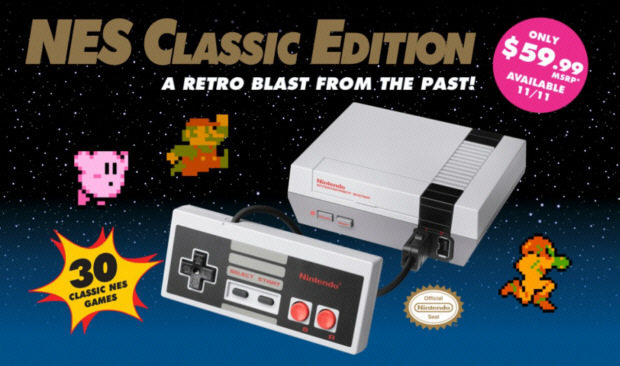
Nintendo got the hype
machine started early but failed to meet consumer demand.
Now with the NES Classic Edition you can play your old classics on a new TV with the HDMI connection, as well as save up to four games no matter what game you play. The system allows you to play in different modes as well. For example, if you want to see the game in its classic pixel and look, you would choose the pixel perfect version. If want to see the game like the original with a slight horizontal stretch to fit your TV, you can do the 4:3 version. Then there is the CRT filter, Looks like an old TV, scan lines and all. The games will also play every time you boot it up. The system comes packaged with 30 games and one controller.
Games included are Balloon Fight, Bubble Bobble, Castlevania, Castlevania II: Simon's Quest, Donkey Kong, Donkey Kong Jr., Double Dragon, Double Dragon II: The Revenge, Dr. Mario, Excitebike, Final Fantasy, Galaga, Ghosts 'n Goblins, Gradius, Ice Climber, Kid Icarus, Kirby's Adventure, Mario Bros., Mega Man 2, Metroid, Ninja Gaiden, Pac-Man, Punch-Out!!, StarTopics, Super C, Super Mario Bros., Super Mario Bros. 2, Super Mario Bros. 3, Tecmo Bowl, The Legend of Zelda, and Zelda II: The Adventure of Link.
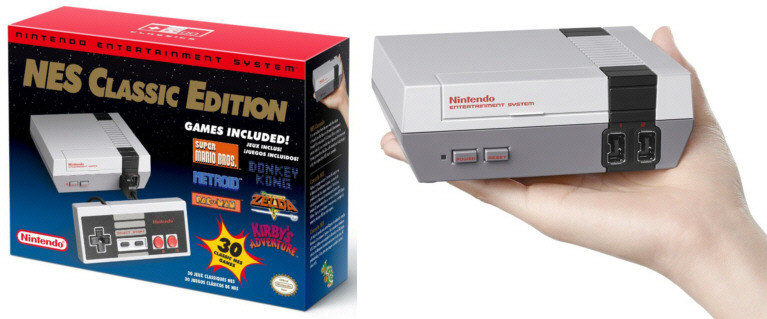
Small in stature but
designed throughout to mimic the style of the Nintendo Entertainment System.
The cool thing about the NES Classic Edition is the size. It can literally fit in the palm of your hand and can be placed anywhere around the TV without taking up room. The HDMI connectivity is a plus when it comes to using newer TVs and having state of the art sound for the classic noises of the 80s. The power button is used exactly like the original and has the red light that indicates that the power is on. The cartridge slot does not open and there is no game expandability. The controllers are almost an exact copy of the original NES controllers, which in a previous issue of The Retrogaming Times I mentioned was one of the most popular and ground breaking controllers of all time. There have been replicas of the controller for PC but never like the original NES version. The new Classic Edition does a very good job on making it feel and play the same as the original. The cord is the only downfall on this. It is short and not cordless so playing the system will have to be the same as the old days, right in front of the TV and sitting close. Being able to save up to four game slots is a plus as well. Games like Super Mario Bros. can be frustrating when you get to level 4 or 5 in one sitting and then have to turn the power off and start all over. This way you can save the game and come back later. This gives players a lot of freedom to find hidden treasure and 1-ups that maybe they didn't want to waste time finding and just wanted to finish the game. Same goes for longer games like Bubble Bobble and Castlevania.
The frustrating thing that Nintendo does, and did to this item as well, is not ship enough of it and not restock them right away. Most GameStop stores and other retailers got form 6 -10 systems at launch and did not take pre-orders. Which means that the first 10 or so people there when the store opened got one and everyone else has to wait. When this article was written, the $59.99 value of the NES Classic Edition was going from $229.00 to $300.00 on eBay. A must have for the holiday season, this has driven up the price. Most stores had no idea when a new shipment form Nintendo will be coming in and there would be no pre-orders allowed. For me, having the original system and games form the 80s was fine. I can still play those 30 games that came on the mini NES, but for those who did not collect or wanted to play The Legend of Zelda or Super Mario Bros. again, they may have to wait until the new year or pay 300 dollars.
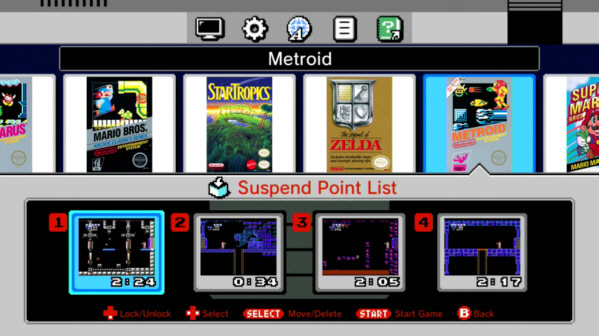
Suspend Points allow
up to four save slots for each game.
Image courtesy businessinsider.com
Overall, the look of the system and the
game themselves stand out from most the plug and play game systems today.
Sega Genesis, Atari and Namco have come out with some cool new retro plug
and plays with feel of the originals, but the NES classic Edition stepped
it up to the next level. Nintendo will always be the most popular
selling brand when it comes to kids toys and games. So, it does not
surprise me that this item will be number one this holiday and beyond.
20 years from now my son will want the plug-in PlayStation 4 30 game bundle,
I am sure.
|
I don't know if this is common in the retro collecting scene but I just don't have much interest for the games that came out before I personally started playing. So anything before the NES and Sega Master System are more of a mysterious novelty, heavily influenced by arcade gaming styles and conventions. A style of gaming that I missed out on by just a few years.
My knowledge of these systems is heavily influenced by the Internet, other people's opinions and popular Internet videos. I'll be frank with you, everything I knew about the Atari 5200 was based on an Angry Video Game Nerd Video. Pitiful, I know. As with most things from before my earliest gaming memories there was some interest there but not enough to go out of my way. I figured someday if I came across it for the right price I'll pick one up.
September 23, 2016 was that someday. I had a few extra dollars in my pocket and was returning from a shopping trip to gather some last minute odds and ends for my woman's birthday. The sun was shining and the wind blowing through the windows of my truck as I drove past what seemed like an endless stream of garage sale signs. Sale after sale I heard the same story. "Yesterday I had some games!" I heard. "You just missed em!" She said. "I just sold a stack of PS2 games for $10..." One soccer mom told me. Almost as if she was just as disappointed as I was that I missed out on the deal while holding her hands to show me just how big the stack was. It was a pretty big stack.
I pressed on and eventually scored an NES and a few Xbox games. Reinvigorated by the fresh find, I pushed on chasing down garage sale signs and asking folks if they had any old games for sale. It looked like I was going to end the day with only the one victory. I started to head home when I received a text from my Mom. She had passed a garage sale and saw something she knew I would be interested in. "I saw a garage sale with a big video game! Maybe they'll have little videogames too!" It read. This didn't immediately make sense so I called for further clarification. Turns out a big video game is an arcade game! Makes sense in the frame of a Mom text. So I follow up on this lead and head on out to the edge of town where this big video game was spotted.
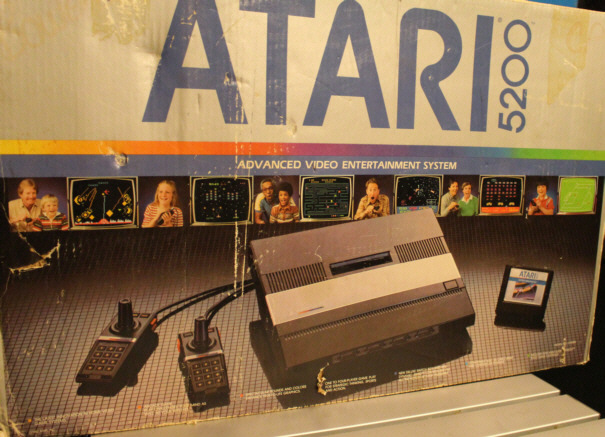
I pulled my truck onto the side of the small country road next to a little corn field, the driveway at the sale was full of other bargain hunters. The arcade cabinet was Atari's ShUUz, a trackball game where you throw horseshoes. I began gazing across the driveway and scanning for any video game related items. My eyes locked onto a large cardboard box. Sitting on the table in the middle of the sale was a boxed four controller port Atari 5200 with what seemed to be 15 to 20 cartridges. Negotiations began immediately. The asking price was $50. Pretty steep for old Jerry "Cheapskate" Terrifying. Using 100% of my Angry Video Game Nerd Atari 5200 knowledge, I toss out the old "Do the controllers work? They're notoriously prone to malfunction." The seller tells me that he just sold another 5200 before I showed up and with it two working controllers. My mind raced... What could have been in this other lot? Was it the two controller port model? Did the first bundle have better games? While thinking about what I could have missed I'm told there are four non working controllers however so I toss out my counter offer of $30. Sold! The only condition was that I take out the double games which seemed reasonable enough to me.
I packed up with my haul of video games and headed home. Over the rest of the weekend I began my research into the world of Atari 5200 controllers. First stop is YouTube to see if there are any tutorials. It wasn't long before I was watching a few other passionate gamers cleaning their 5200 controllers. It would seem that getting one of these controllers to work really isn't that much hassle at all. Open the controller, use a pencil eraser to clean the flex board contacts and reassemble. Further research led me to www.best-electronics-ca.com which is an amazing website that any seasoned retro gamer has no doubt been to before. There is a tutorial for replacing the flex board with a gold plated flex board and new buttons with gold plated contacts that will prevent the controllers innards from corroding and getting dirty. This upgrade appears to be $45 which is a few more dollars than I'd like to spend on a controller upgrade at the moment. For now the cleaning method will do, so I get to work.
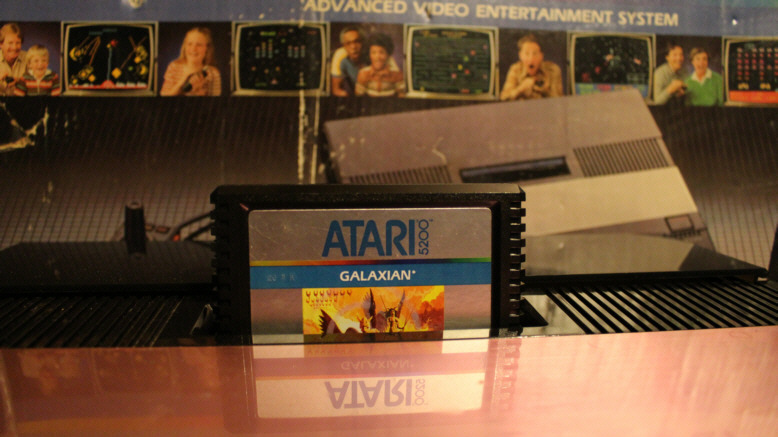
About an hour later I had four working Atari 5200 controllers. One of the controllers is the revision 9 controller which is the last revision of the controllers inner workings and the most reliable. This will be my primary controller as I get to testing the system itself. The RF signal is not very clean but it could be that the cable connected to my 35 inch Sony Trinitron is not heavily shielded. Not wanting to move that monstrous TV to get back to the coaxial input, I make due. The rest of the day is spent playing Galaxian with a spot of Missile Command. The analog control is phenomenal with these two games. The level of control I have over the ship in Galaxian is superb much to my surprise. If only the rest of the world knew how easy it was to clean these controllers and enjoy the system. Perhaps some day in the future I'll perform an S Video mod to get rid of the staticky RF signal to truly enjoy some Galaxian. In the meantime I'll be keeping an eye out for more Atari 5200 games to add to the collection.
Jerry sporadically produces a video
game podcast called The Mondo Cool Cast, featuring all eras of video gaming.
It can be found on iTunes and at www.mondocoolcast.com.
He also produces a cable access show about video games, which can be found
at www.youtube.com/jerryterrifying
along with other video gaming focused content.
|
This is a cool but sad story of a classic game and how it became a permanent keepsake in my collection as well as my life long memory. One of my favorite games of all time is original The Legend of Zelda for the NES. I remember when it first came out and I waited in line early to get the game in its unique gold cartridge. Back then getting something like that was the talk of the town. The year was 1987 and it was a great year for Nintendo. Super Mario Bros., Mike Tyson's Punch-Out!!, Castlevania were all out to name a few. But the Legend of Zelda was different, it was way ahead of its time and an adventure that was perfect for the NES and kids of that generation. I waited over 3 hours in line to get my hands on that gold cartridge and was excited to play and show my friends. It was the first vivid memory I have of playing a console game constantly for hours on end without getting bored or stopping. The game taught me adventure, secrets, strategy and battles that are still used in today's video gaming world. Needless to say, I played this game more than any other game I may have played in my life. I have kept that original 1987 gold cartridge with for my whole childhood and adult life. It was one of the only original games I kept over the years. The rest of my over 3200 console games have been re-found and purchased at thrift stores, conventions, craigslist, and other social events. The Legend of Zelda was a piece of history that stayed with me forever. Until 2010 when the game I had for almost 23 years without any damage or scratches was altered forever.
In 2010 my video game collection was beginning to grow tremendously. I think I was at almost 1000 games by then and I was proud of my collection. Atari, NES, Genesis, PlayStation, Xbox as well as dozens of other systems and hundreds of games. My birthday was coming up in October and my wife saw an awesome clock that someone on the internet made out of a NES cartridge. He was selling this item online and my wife thought it would be an awesome gift. However, since it was unique and made by a seller online, the price was extremely high for an item like that. Plus, she wasn't sure I liked the game that it was made from. My wife Erin had a great idea of building the clock herself out of one of the games in my collection. This way it would be more sentimental and a game that I liked since it was part of my collection.

My wife searched my collection in the garage of games that I had organized by systems. She knows that NES is one of my favorite systems so she started by looking through those games. She wasn't sure at that time which game was my favorite, but she looked through the stack to find one maybe she was aware of and one that was popular. Well, after a few minutes one stood out more than any other in my NES group. It was a shiny gold cartridge that she knew would look awesome as the final product. This game was of course, The Legend of Zelda. The game I kept all those years as a childhood memory and a game that always stood the test of time. She grabbed the game and began the research of making a NES game into a desk clock.
The steps involved in making a NES clock were not that complex, however it did involve some parts and some deconstruction of the cartridge to make it work. With the help of her father, they began the quest in making the clock for my birthday. The first step was to get the mechanism to work; the second, minute and hour hands can be found at Michael's or other craft stores. The next step was to remove the game board that is inside the cartridge so you donut damage it and you can use it again one day. The last step was drill a hole into the cartridge to get the... NO way!! Yes. I said you need to drill a hole into the cartridge. Without knowing the history of the game to me and the significance of that game in my life and collection, she went ahead and drilled into the game and began the journey of making my NES Legend of Zelda cartridge into a clock. Coincidentally, because my collection was so big and I didn't play my NES that month, I did not realize that in the weeks to come my Zelda game was missing.
October 18, 2010. Birthday time. The excitement of getting possible new games or t-shirts or anything game related was on my mind and having my family with me to celebrate made it a special day. Soon I would find out that it would be a VERY special day with laughter and a memory that will last forever. I opened my gifts as I saw them, but my wife told me to save a special gift for the end. So after opening my gifts of games, t-shirts and other fun gaming items, it was time to open the very special gift my wife was very excited to give me. I slowly opened the gift and realized it was in a ordinary store box. My wife is famous for boxing up gifts in different boxes so you are more surprised when you first see the box. I knew that the box I saw was not the gift inside, so I was anxious to see what it was. I opened the box and pulled out a NES cartridge which was at first glance the only game I could recognize right away, The Legend of Zelda. I turned the game around and saw it was a clock. It was so cool!! I could not believe she found such an item and I was in possession of it. I asked where she got it and she told me she made it herself. OH! Very cool. Ummm. Cool. Where did you find the cartridge? Gulp... She told me that she found it in the garage. Surprise!!! OH WOW! Yes. Ummm, it is the coolest, umm... sweet. Wait!! The garage? This was my game? Being the cool awesome husband I am, I smiled and said it was the coolest thing I had ever seen. But then the other side of me said, holy crap, the original NES cartridge I have had for 20 something years has been deconstructed. Mixed emotions hit me as it was so cool to have, but I had so many questions. Where is the game inside? How did you attach the clock hands? Will it still play one day? Can we put it back the way it was? Now I was smart to know that in the world today I can easily find another Zelda cartridge at a convention or eBay or whatever, but the idea that kept it for so long and it great condition and it was now a clock was an eye opener.
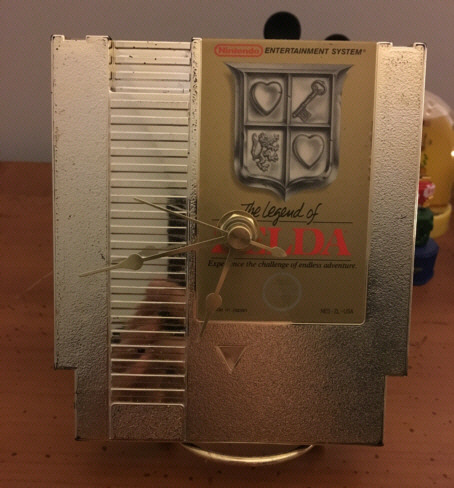
In retrospect, looking back I am so happy
my wife made this momentous item, that today I still have and use on my
desk at work. It has only needed to be replaced once with new hands
but it works like a charm. And as you have read, it makes a great
story that will last forever. Oh, yes, I did get another copy of
Zelda and the original Game board inside is now inside a Super Mario Bros.
cartridge, which is cool in itself.
|
The Final Fantasy column this issue got me thinking about console RPGs and another huge franchise, Dragon Quest, that has been intertwined with Final Fantasy from their beginnings. While both series are extremely popular world wide, with Final Fantasy being the more popular franchise in North America, Dragon Quest is virtually a religion in Japan. Both games owe a tremendous debt to Ultima III but went different ways in bringing a satisfying role playing experience to video game consoles. Yuji Hori had success in bringing the text-based adventure game to consoles with his murder mystery game, Portopia Renzoku Satsujin Jiken (The Portopia Serial Murder Case), released for the Famicom in 1985. Although the game utilized a text parser in the original 1983 computer releases, this wouldn't be feasible with a standard controller, so a command menu was utilized along with a point-and-click interface. Portopia was the first adventure game of its kind released on the Famicom, where it found solid success and spawned the console adventure game genre. After consolizing the adventure game, Hori then looked to doing the same to the complexity of computer role playing games.
The idea was to introduce the RPG to console and casual gamers, those who were entirely unfamiliar with the genre or computer gaming in general. The interface would be simplified and streamlined with less emphasis on statistics and more on visuals and storytelling. Akira Toriyama, who was riding a huge wave of success due to the popularity of his Dragon Ball comics, was hired to create the game's artwork including all the in-game characters and enemies. The result of this project was Dragon Quest, effectively a Western computer RPG redesigned with the sensibilities of Japanese console gamers in mind. It really did turn the RPG on its ear as it afforded a much gentler learning curve and a more instant reward system. Rather than hating the player's guts from the start and beating them over the head with failure, Dragon Quest provided players with a clear set of breadcrumbs to follow in order to make progress in the game. Step out into the overworld, fight a few low-level monsters, and "do-dah do-do-do-do," gain an experience level while a little fanfare plays. That alone was the biggest difference over Western computer RPGs. Rather than making statistic building a chore or something that had to be constantly managed, Dragon Quest let it happen naturally, giving players little rewards as they accomplished basic tasks. You could play Dragon Quest for twenty minutes and fully grasp the mechanics of the entire game. It was an RPG that anyone could play and enjoy. Dragon Quest was even more successful than Portopia and its success laid the foundation for the console role playing game genre. Even Final Fantasy was built upon the mechanics introduced to console games with Dragon Quest. The two franchises would carve out their own niches as time moved on, with Final Fantasy continuing to become more experimental, and Dragon Quest assuming a "comfort food" approach of familiarity. The great thing about each series is they both fulfill different expectations, giving choice to those who play them.
Thank you once again for reading The Retrogaming Times. We'll be back on March 1st with our next issue. Be sure to follow The Retrogaming Times on Facebook and join our new community! I sincerely hope you enjoyed this issue and that you will return to read the next issue and possibly submit an article yourself. Remember, this newsletter can only exist with your help. Simply send your articles directly to me at trt@classicplastic.net or check out the submission guidelines on the main page. Submit an article today and join a great retrogaming tradition!
See You Next Game!

Content and opinions on this
page are those of their respective writer(s)
Assembled and published
by David Lundin, Jr. on January 7th, 2017 at ClassicPlastic.net
© 2017 The Retrogaming
Times. All Related Copyrights and Trademarks Are Acknowledged.